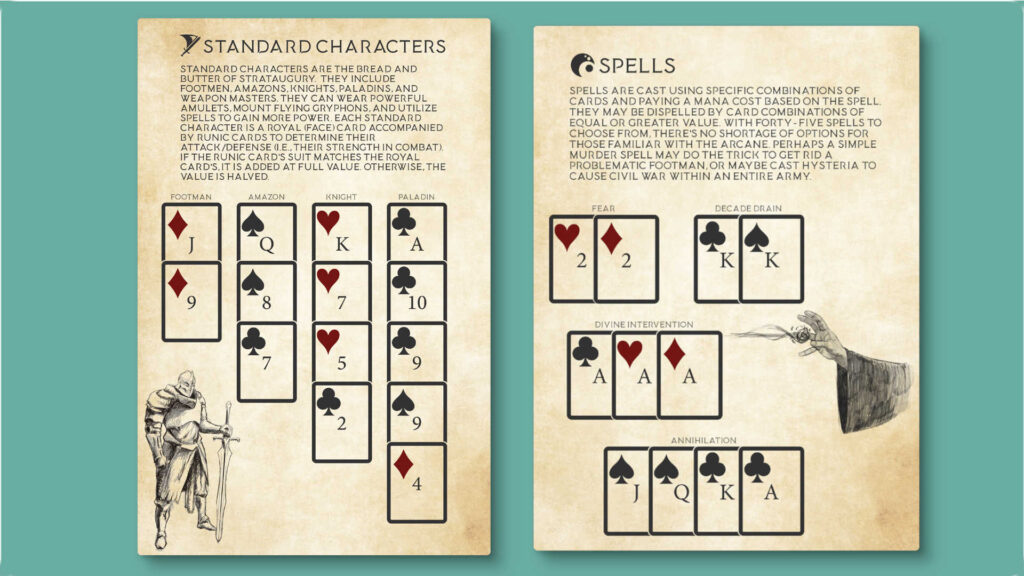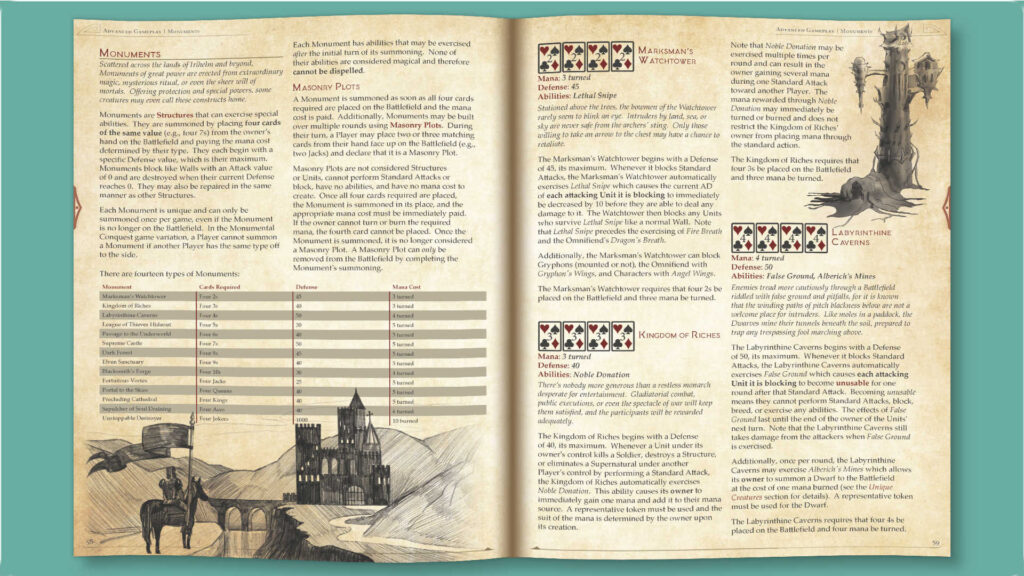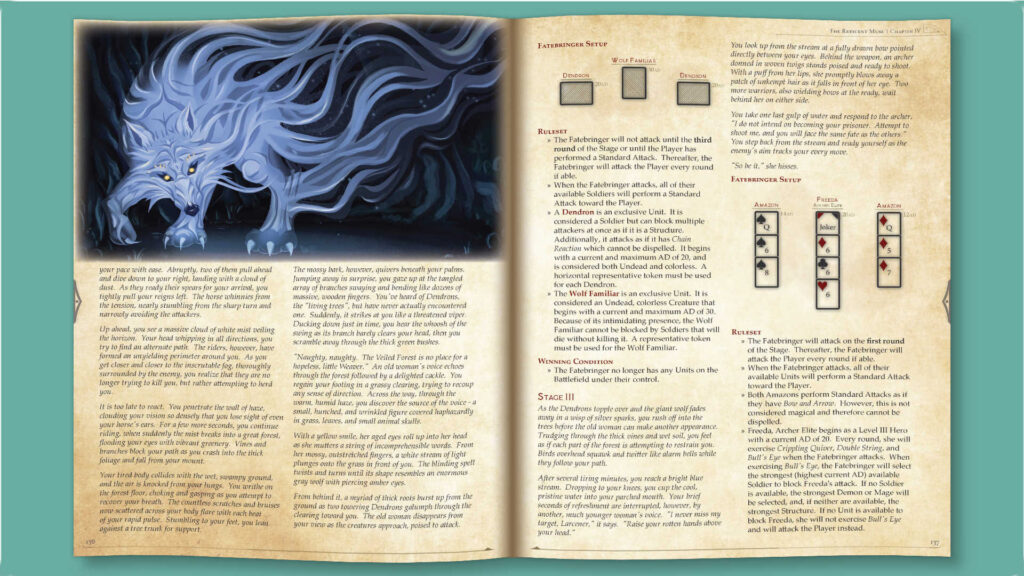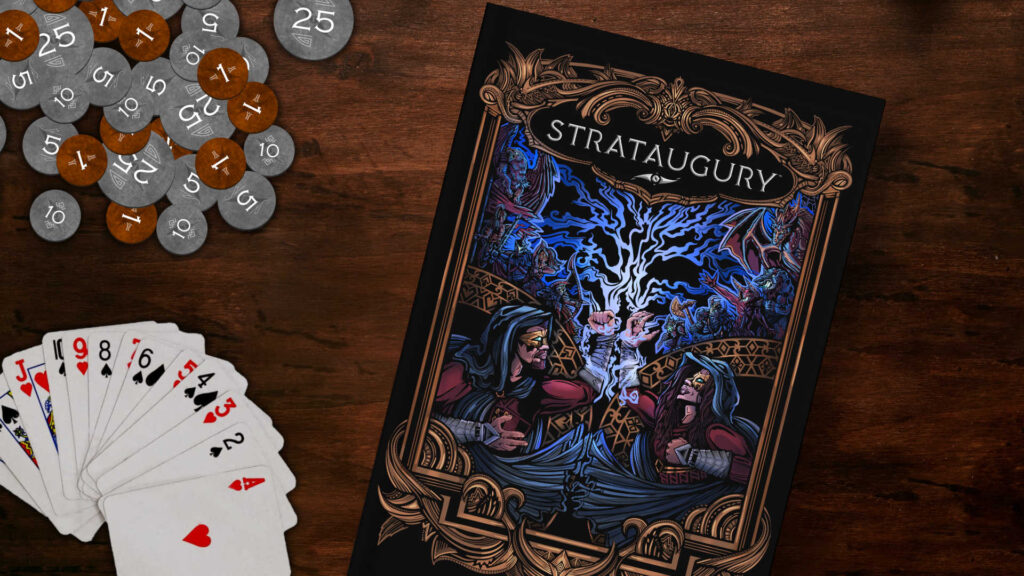The standard deck of cards is the most versatile tool in any gamer’s library; not only does that single, 52-card deck provide near-limitless, well-known games to play, such as Poker, Bridge, Solitaire and more, but it’s also been utilized by modern game designers to provide surprisingly in-depth experiences to rival the biggest and most expansive card games.
Strataugury is one of those games; though it uses a standard deck of cards, the sheer depth and wealth of strategic options available on each turn is genuinely impressive. Let’s take a closer look at Strataugury, and see if its gameplay matches the scale of its ambition.
Table of Contents
ToggleWhat Is Strataugury?
The passion project of Indigo and Nathaniel Brown (no relation to me, I must hastily add!), Strataugury is a game that’s been years in the making. It’s a game which seeks to replicate the experience of summoning and battling in Trading Card Games (or TCGs) such as Magic: The Gathering, without the high financial investment that players must make in order to succeed in those titles.
All you’ll need to play Strataugury is a standard deck of cards per player and a variety of counters (in different sizes or colors) in order to track various card statuses. Oh, and of course you’ll need to have access to the Strataugury rulebook, an almost shockingly weighty and dense tome, which wouldn’t look out of place next to Dungeons & Dragons Player’s Handbook or Dungeon Master’s Guide!
How to Play Strataugury
At the beginning of a game of Strataugury, players shuffle and cut their decks, with the highest card revealed determining who takes the first turn. It’s possible to play with more than two players; if you are, play order is clockwise from whoever revealed the highest card (in the case of a tie for highest, the players involved cut and reveal again until there’s a winner). All players then shuffle again and draw 10 cards for their starting hands.

The turn structure in Strataugury will be very familiar to anyone who’s played a TCG before; players first draw a card from their deck, refresh (that is, in Strataugury parlance, ‘unturn’, which is analogous to ‘untapping’ in Magic: The Gathering) their mana cards and then perform any number of actions that their mana or other cards allow for. Though most actions can be carried out multiple times (providing the cost can be paid for doing so), such as character or structure summoning, casting spells or even breeding creatures, attacking can only be done once per turn (though you can attack with one or all of your units during this action), placing mana is once-per-turn only, as is (naturally) the end of turn declaration. Ending a turn can only be done if a player has 10 or fewer cards in their hand.
Not only is the general order of play fairly familiar to seasoned TCG players, but combat should be pretty recognizable in structure too; a player performing a standard attack announces which of their units is attacking, then the defending player chooses blocking units. The defender’s blocking units can block each block 1 attacking unit at a time, and they choose which units to block with their own, and in which order.

Each unit has an AD value (Attack/Defense), determined by the current total of the cards they have in their AD ‘slots’ (each unit type, represented by a Royal card, including Aces and Jokers, has a certain number of slots to place cards into). Damage is dealt according to the unit’s current AD value, with the blocking unit taking damage to their own AD to the total of the attacker’s current AD. The blocking unit deals damage too, using the same principle. Damage in the resolving attack/blcok doesn’t affect the current AD of each unit in the battle, as the damage from both units is dealt simultaneously. When a unit’s AD is reduced to 0, their card and all cards in their AD slots are discarded.
There’s a few extra rules here; the blocking player can instead choose to take damage to their own health (each player starts at 30, and reducing a player to 0 will eliminate them from the game), and structures can be used to block multiple units, but don’t deal damage in return.
Is Strataugury Fun to Play?
I’ve been genuinely impressed with how deep and strategic Strataugury is, considering the fact that such a minimal, cheap and easily obtained set of components are needed to get started with it. The rulebook itself is genuinely beautiful, with the feel of a classic TTRPG guide or sourcebook; its fantastic illustrations and general aesthetic really do drive home the fantasy battle nature of the game.
The game offers an amazing array of uses for the cards in your deck; though it only uses the standard, four suit (plus two Jokers) selection of cards, each card can have multiple purposes, meaning that players with their hand of 10 cards can use them in an almost dizzying number of ways in order to play the game.

Which brings us to the elephant in the room with Strataugury; its ambition, depth and versatility can sometimes work against it. Learning to play the game is pretty tough, and felt daunting even when using the cut down, quickstart version of the rules. Once you have the basics down, that relatively familiar turn structure really helps to make sure that players at least know the structure of turns and the options available to them, but with cards having multiple uses, and such a large variety of units, creatures, spells and more to familiarize yourself with, it feels even after a few games like the rules reference will always need to be close to hand.
That’s because of it using a standard deck of cards, which becomes a double edged sword. Though it means that just about anyone can pick up and play Strataugury very quickly and cheaply, it feels like it’ll be next to impossible to recall the details of each spell, unit type or creature that can be spawned, with each unit or creature having their own specific rules, keywords or abilities.
Of course, with most games of this type, again referring to the example of Magic: The Gathering (though of course just about any TCG can apply here), specific rules, unit types and keywords are all contained on each card, which avoids the problem that Strataugury players may encounter.

That said, it’s still very impressive to see such a deep and strategically interesting game emerging from the humble, standard deck of playing cards, and it’s certainly a very ambitious undertaking by the designers. If players don’t mind keeping the rules reference to hand while playing Strataugury, they’re likely to find that it’s a fun, fast-paced and involving experience that goes much further with its concept than may be expected. The full rulebook, excitingly, even offers two narrative heavy campaigns for solo players to play through; another strong selling point for this unique game.
The Card Gamer Verdict
Given that the game is played with only a standard deck of cards and counters per player, Strataugury is a stunningly ambitious design that feels like a game which would usually cost many times the price you’ll pay to play it.
This can lead to a few issues, however, with the learning curve, and ongoing need to reference the different types and abilities of each card, making Strataugury less accessible and slightly fiddlier to play than comparable titles.
However, it’s hard not to be impressed with what Mysterial Entertainment have accomplished with Strataugury, with a beautifully designed and useful rulebook, and a flexible, broad set of gameplay options allowing multiple uses for each card in your deck, even extending to solo play with two solitaire campaigns.
Despite the abstract nature of the game’s aesthetic during play, Strataugury’s rich, flavorful rules do add some fantastical ambience, and it’s admirable that the game avoids the need for players to invest in anything other than its excellent, if slightly overwhelming, rulebook.
Strataugury is currently crowdfunding via Kickstarter.
You can also check out our review of River Rats, another game which is played using a standard deck of cards!





